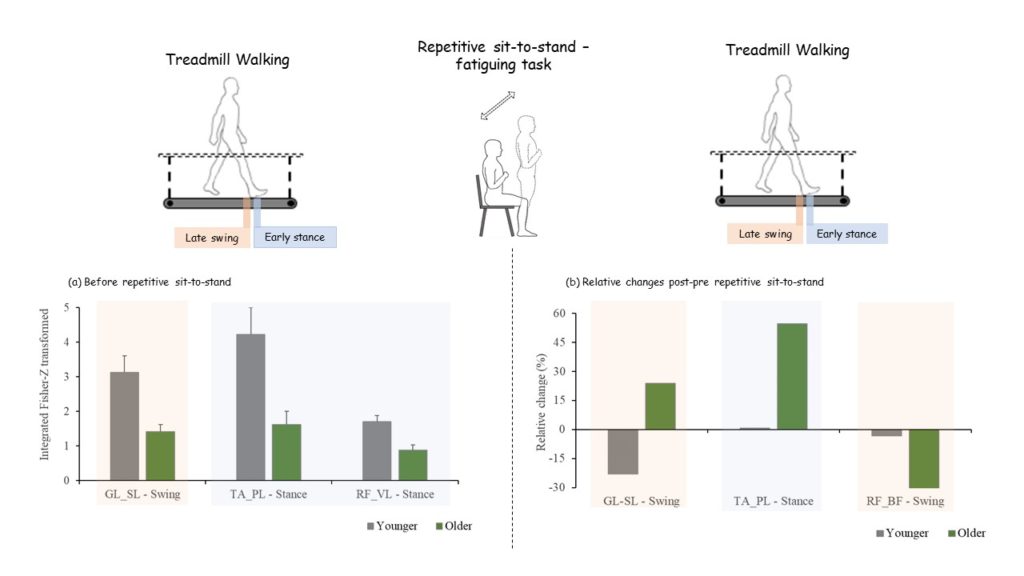By Dr Paulo Cezar Rocha dos Santos
Perturbations to a healthy person’s walking can emerge from external (e.g., slip, trip) and/or internal constraints. Without a fast and effective response, perturbations lead to a loss of balance and falls. Internal perturbations might originate from a state of fatigue, limiting the capacity to allocate internal resources during a motor task. Because of age-related reductions in neuromuscular function, older adults might have increased difficulty adapting the neuromuscular control of walking when fatigued. Neuromuscular control can be assessed by intermuscular beta-band (15-35Hz) coherence, which is an indirect indication of a common neural drive to two muscles.
In a study published in Scientific Reports, we examined the effects of age on intermuscular beta-band coherence during treadmill walking before and after an experimentally induced fatiguing task. Twelve older and 12 younger adults walked on a treadmill for 3min, at 1.2 m/s, before and after performing a repetitive sit-to-stand test (fatiguing task). We calculated gait metrics (length, width, swing and stance time, cadence) and intermuscular coherence in late swing and early stance phases in knee and ankle synergistic and antagonistic muscle pairs from 100 strides of data.
We observed only minimal effects of age and fatigue on gait metrics. However, before a repetitive sit-to-stand test, we observed that, compared with younger, older adults had lower (48-62%) coherence in synergistic muscle pairs (Figure 1a). After a repetitive sit-to-stand test, gastrocnemius lateralis-soleus coherence in swing decreased by ~ 23% and increased by ~ 23% in younger and older, respectively (Figure 1b). We also observed that tibialis anterior-peroneus longus increased by 16%, and rectus-biceps femoris coherence in late swing decreased by ~ 20%, independent of age (although this difference seems to be driven by older adults, Figure 1b).
We interpreted the weak intermuscular coherence in old age as the central nervous system’s inefficiency in reducing motor control’s complexity by sending common drives to synergistic muscles. Fatigue may elicit an age-specific compensation in neuromuscular control whereby despite lower-limb fatigue, older adults increased intermuscular coherence between ankle synergistic muscle pairs enabling them to keep walking.
To sum up, this study improves our understanding of how healthy aging brings about adaptations during gait and how such adaptations could change into compensations to maintain walking performance.

Figure 1. Intermuscular beta-band coherence before and after experimentally induced fatigue (repetitive sit-to-stand protocol) in younger (gray bars) and older (green bars) adults; a) mean and standard error of beta-band coherence before a repetitive sit-to-stand test; b) relative change in percentage induced by a repetitive sit-to-stand test in late swing (orange) and early stance (blue) phases. GL: gastrocnemius lateralis, SL: Soleus, TA: tibialis anterior, PL: peroneus longus; RF: rectus femoris, VL: vastus lateralis, BF: biceps femoris. Figure adapted from Santos et al., 2020.
Publication
dos Santos, P.C.R., Lamoth, C.J.C., Barbieri, F.A. et al. Age-specific modulation of intermuscular beta coherence during gait before and after experimentally induced fatigue. Sci Rep 10, 15854 (2020). https://doi.org/10.1038/s41598-020-72839-1
About the Author

Paulo Cezar Rocha dos Santos
Department of Human Movement Sciences, University Medical Center Groningen, University of Groningen, Groningen, The Netherlands. Posture and Gait Studies Laboratory (LEPLO), Institute of Biosciences, Graduate Program in Movement Sciences, São Paulo State University (UNESP), Rio Claro, Brazil
Paulo recently pursued a double PhD at the Center for Human Movement Sciences, University of Groningen (The Netherlands), in partnership with São Paulo State University (Brazil). His current projects focus on understanding the underlying mechanisms related to gait and postural control in healthy and neurological populations.
Copyright
© 2020 by the author. Except as otherwise noted, the ISPGR blog, including its text and figures, is licensed under a Creative Commons Attribution-ShareAlike 4.0 International License. To view a copy of this license, visit https://creativecommons.org/licenses/by-sa/4.0/legalcode.
ISPGR blog (ISSN 2561-4703)
Are you interested in writing a blog post for the ISPGR website? If so, please email the ISGPR Secretariat with the following information:
- First and Last Name
- Institution/Affiliation
- Paper you will be referencing


